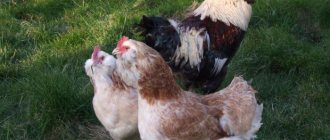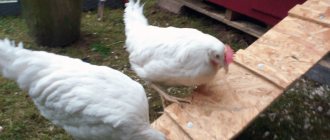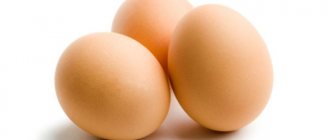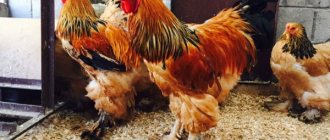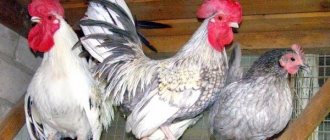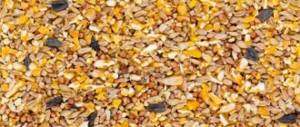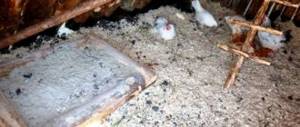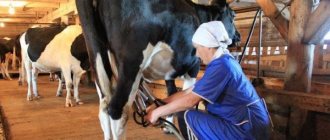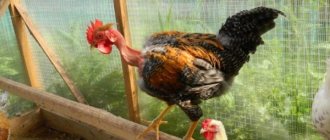Description of the breed
Photo:
The Moscow Black has powerful muscles and an elongated body, black dense plumage interspersed with gold or copper color, which are more numerous on the lower back, shoulders and mane. Based on color, birds are divided into 2 types: the first - with a golden-yellow color on the back and mane of the rooster and the mane of the hens, the second - with a copper-red color.
Characteristics of the head: the wide head is decorated with a leaf-shaped erect comb with delicately carved teeth. The curved black beak is of medium length. The eyes are orange, or optionally dark brown. The lobes are white or red.
Body description: a convex wide chest, a long straight back and widely spaced legs give the Moscow Black chickens a powerful appearance inherited from the ancestors of the fighting breed. Well-developed wings and tail are of medium length, the tail is set low.
Description of legs: Dark colored legs are darker in hens than in roosters. The tint of the legs may be greenish. Birds with yellow legs and beaks are strictly culled during breeding.
Chickens are mostly black, but lighter coloring of the crown and light spots on the belly, chest, and under the tail are allowed. The wing plumage may contain several white feathers, which disappear in an adult bird.
The Moscow Black breed is unpretentious in terms of feed and living conditions. Thanks to its dense plumage, the bird tolerates even unheated winter quarters well. What makes this breed even more valuable is its high resistance to disease.
A gift for those who decide to breed this breed of chickens is excellent egg fertilization and almost one hundred percent survival rate of chickens. The main disadvantage of the Moscow black chicken is the inability to distinguish the sex of chickens until almost 1.5 months.
Advantages and disadvantages
The breed is easy to care for
After reading the description, you need to decide on the main advantages of Moscow chickens:
- endurance and good immunity against many diseases;
- calm disposition;
- high degree of stress resistance;
- excellent taste of meat and eggs, as well as good meat and egg productivity;
- undemanding to the quality of food and living conditions.
There are several disadvantages:
- poor brooding instinct, so breeders often have to use an incubator for breeding;
- delayed egg production - six months after birth;
- the productivity indicators of laying hens will not last long - about 3 years;
- birds are prone to obesity when overfed.
Origin story
The Moscow Black chicken breed was bred by breeders from the Brattsevskaya poultry farm together with scientists from the poultry farming department of the TSHA. As a result of long-term work with the original breeds of Yurlovsky Vociferous, New Hampshire and Brown Leghorns, a universal breed was obtained, suitable for home and industrial breeding.
They were not chosen by chance: Leghorns - due to their high egg production (more than 200 eggs per year), Yurlovskie - for their vitality, New Hampshire - for their increased productivity and large size.
By selecting individuals with high immunity, breeders managed to create a breed of chickens that is resistant to infectious diseases and rarely gets sick. The Moscow black breed of chickens was officially registered in 1980.
The breed includes several (currently 5) subspecies and lines. After some time, the line degenerates and productivity indicators drop. Breeders are still working to improve it, consolidating and developing the necessary qualities.
The Moscow black breed of chickens has attracted the interest of summer residents and farmers. Positive reviews from the first chicken owners contributed to the widespread distribution of Moscow Black chickens.
History of origin
Scientists from the Moscow Agricultural Academy "Solnechnoye" worked on the creation of this chicken. This idea was conceived in order to breed a new, highly productive chicken that would produce both excellent meat products and a large number of eggs. In addition, the chicken had to have a decorative appearance, strong immunity and a non-conflict character.
Three breeds were selected for work:
- Leghorn.
- New Hampshire chickens.
- Yurlov breed.
Thanks to breeding work, it was possible to obtain Black Moscow, which was approved in the 80s. Soon it became incredibly popular in the Moscow region and beyond.
Reviews from poultry farmers
The Moscow black breed of chickens is loved by many poultry farmers who are happy to raise it. In their reviews, many note that there is no breed more adapted to Russian conditions. The Moscow Black easily withstands conditions that would put any other breed of bird to the brink of death.
Even in unheated poultry houses, they can easily withstand winter frosts down to -30°C. Roosters can experience frostbite on their combs, but more serious consequences are very rare. To keep warm, you can place an infrared lamp above the perch.
In a well-insulated room, where the temperature is kept close to 0°C, chickens continue to lay eggs well even in winter. Some hens can even incubate eggs at this time. If there is enough food, the egg production of birds is not reduced. Instead of drinking, the chickens calmly peck at the snow.
Despite the high cold resistance, warmth in the chicken coop will not hurt Moscow blacks. Covering the floor with straw and good insulation will help them survive even the harsh winter without any problems.
The Moscow black breed of chickens is not picky about feeding and housing conditions. Dense plumage helps the bird to easily endure the harsh seasons. Chickens of this breed are resistant to diseases. Due to its high vitality, poultry breeding is economically profitable and justified.
For all its advantages, the Moscow black breed of chickens also has some disadvantages:
- tendency to obesity due to overfeeding;
- eggs for incubation can be selected only after puberty, at 8 months of age;
- the brooding instinct is poorly developed.
These disadvantages do not affect the popularity of the bird: most poultry farmers choose this particular breed of chicken for keeping.
Growing Moscow black breed at home
Based on the characteristics of this species, there are a number of maintenance rules that ensure that birds lay eggs better and the quality of their meat increases.
Did you know? Chickens have an excellent sense of time, so if there is a scheduled feeding in the yard, it means that the birds will always be there at the right time.
Conditions of detention
This breed is kept both indoors and in the walking yard. And each option has its own requirements.
Premises requirements
It is important for chickens to ensure optimal temperature and humidity in the house. The room should be at least +16 ºС if older birds live there, and at least +21 ºС when it comes to chickens. If the room is too cold, the hens will stop laying eggs. When overheating occurs in the room (at temperatures above +35...+40 ºС), the birds may even die. Thin shells or reduced egg size may also indicate that the indoor environment is too hot.
Important! Lack of moisture disrupts the functioning of the respiratory system, mucous membranes and leaves a negative imprint on the plumage.
If the microclimate is normal, then this is noticeable in the behavior of the birds themselves: they run and cackle. In this mood, chickens actively eat, drink, walk, and do not huddle or form flocks. Humidity is also a significant indicator; it should not be lowered below 60–70%. To ensure this, make sure there is ventilation in the chicken coop. Excessive moisture creates conditions for mold on the walls and dampness.
Another important factor in arranging a poultry house is litter. Her presence is mandatory, but the composition differs depending on the season. In summer, it is better to cover the floor with sand: birds love to flutter there, cleaning their plumage to prevent parasites. A layer of 15–20 cm will be sufficient. During cold periods, various materials are used as bedding:
- straw;
- fallen leaves;
- ground hay;
- husks from seeds, etc.
This coating perfectly absorbs moisture from droppings and also retains heat during cold weather. Moscow black chickens are quite hardy, so this kind of “warming” is quite enough for them in winter. The thickness of the layer in the cold season should be up to 0.5 m. For such purposes, it is necessary to prepare materials in the summer, when it is possible to dry them efficiently. It is recommended to harvest at the rate of 10–15 kg of litter per bird per season.
Did you know? Roosters have a genetic predisposition to fight. This is what explains their cockiness and readiness to engage in battle with an enemy much larger in size.
In winter, you need to take care of the presence of lighting in the chicken coop. Since the daylight hours during this period are much shorter than usual, it is necessary to extend it individually so that this does not negatively affect the egg production of laying hens. To do this, it is necessary to place light bulbs at least 2 meters at the rate of 1 lamp per 6 m².
For chickens of the Moscow black breed, it is better to purchase or make a brooder yourself, taking into account the minimal craving of these chickens for motherhood. Caring for the young will fall entirely on the shoulders of the owners, but the need for care usually does not last long. Since these birds are famous for their health, 1–1.5 months in a brooder will be enough for the chickens to get stronger.
Walking yard
Its presence is not necessary, but desirable for birds of this species. Moscow black chickens are famous for their calm character, they are not shy, so you can do without high barriers in the walking yard. For the comfort of your chickens, create a canopy over your walking area to protect them from heat and excessive sunlight.
Important! Be sure to make sure that there are no sharp or thorny places on the yard that could injure the bird.
Feeders and drinkers
Waterers and feeders should always be in the coop and in the run yard, if there is one, so that the chickens can always replenish their strength.
When choosing a feeder, adhere to the following recommendations:
- it should be an elongated container made of wood or metal;
- for one bird you need to plan at least 10 cm of feeder length, otherwise someone will be malnourished, and someone will suffer from overeating;
- Place them on a high spot so the birds can reach the food without having to scoop it up on the ground.
Regarding the drinking bowl, the main requirement for it is that the chickens do not have the opportunity to create a swamp around it.
Therefore, select structures where birds can drink water, but will not splash it. Also, do not take containers larger than 5 liters, otherwise in the heat the liquid will quickly deteriorate and become a source of harmful bacteria. Did you know? In Central Asia, “bald” chickens are often found, which were bred specifically to exist in hot climates.
Feeding
Varied and timely feeding is the key to the healthy development of Moscow black chickens. Therefore, we should talk in more detail about their diet.
Chickens
Feeding chickens deserves special attention, since immunity is established from birth. To ensure the healthy development of your livestock, follow these step-by-step instructions:
- For the first week, the chicks should be fed finely ground corn grits and finely chopped boiled eggs.
- On the third day of life of young animals, it is worth adding chicken feed and green onions to the diet.
- From the second week you can already give cottage cheese.
- Boiled vegetables are added to the diet of chicks only from the third week of life.
- After this, you can gradually feed the chickens crushed grain.
Make sure there is always food in the feeders, as chicks eat very often.
At the end of the second month of life, the young animals are ready to switch to adult food. Important! This species is prone to obesity, so it is best to prevent them from overeating.
Adults
Considering that Moscow chickens belong to meat and egg breeds, they require on average 15–20% more nutrition than in the case of other species. The basis of their diet is feed and hay flour. But in the summer the second ingredient is usually replaced with:
- greenery;
- fresh vegetables;
- fruits.
In winter, the chicken diet is often supplemented with boiled potatoes. For full development, 3 meals a day are enough for them.
Planned herd replacement
Sexual maturity in birds of this breed occurs after 8 months of life, after which their eggs can already be taken for incubators. This species rarely hatches eggs on its own, so they are propagated mainly artificially. Chickens lay most actively until the age of 3-4 years, after which their egg production drops and the quality of meat begins to deteriorate. Therefore, it is during this period that it is recommended to carry out a planned replacement of livestock.
Did you know? The longest chicken flight lasted 13 seconds.
Shedding
Like representatives of other breeds, Moscow black chickens molt in the fall. This process takes them up to three months, so by winter the birds already have completely renewed plumage.
At this time, chickens become more lethargic, laying hens practically stop laying eggs, directing all the body’s forces to restore their feather cover. Owners can add strength to their pets and speed up shedding by supplementing their diet with nutritional supplements:
- greens;
- beets;
- zucchini;
- pumpkin
Productivity
The Moscow black breed of chickens is a meat-egg breed. Thanks to the work of breeders, birds have acquired qualities that are almost as productive as egg breeds, and meat quality indicators are superior to such breeds.
The live weight of Moscow Black roosters reaches 3-3.5 kilograms, chickens - 2-2.5 kilograms. Egg production averages 220-240 eggs per year, some individuals can lay up to 280 eggs per year. To produce 10 eggs, the feed consumption is less than 2 kilograms.
At the age of 5-6 months, hens of the Moscow Black breed begin to lay eggs. Some individuals, with good care, can begin laying eggs at 4 months. Depending on the specific conditions of detention, the weight of eggs reaches an average of 55-60 grams. Fertility reaches 90%.
The meat quality of Moscow blacks is much higher than that of egg-laying chickens. Due to the developed muscle mass, the meat yield is greater, but much less than that of broilers. Black plumage and dark down make it difficult to process the carcass due to the large number of black stumps, especially if the bird was killed during molting.
Many people note the harshness of the meat of Moscow black breed chickens and the unattractive appearance in main courses. At the same time, it is perfect for soups and broths. The toughness of the meat is due to the fact that it is mainly used for excess roosters. When choosing the most suitable producer, many farmers are forced to keep the cockerels for up to 7-8 months.
Diet
In order for chickens to lay many eggs, they need to be fed properly. Their diet should be balanced and necessarily include the following products:
- Squirrels. Chickens need proteins to form eggs and quickly gain weight. A large amount of proteins is found in legumes, rice, mash, etc.
- Vitamins and beneficial microelements. Experts advise giving the bird fish oil, yeast, and plenty of fresh grass.
- Minerals. It is very important to provide chickens with the necessary amount of minerals. Thanks to them, the crusts form a strong backbone and a strong eggshell. Sources of minerals include: chalk, crushed eggshells, crushed shell rock. Of all the sources described above, crushed shell rock is best suited. In the case of crushed eggshells, you need to be extremely careful, because if the hen recognizes an egg in the shell, she may begin to peck at the laid eggs and it will be very difficult to wean her from this habit. As for chalk, this is the worst option, since if chalk is used frequently, it can stick together and cause clogging of the gastrointestinal tract.
- Carbohydrates. The activity and endurance of the bird depends on the amount of carbohydrates. Chickens get most of their carbohydrates from grains and vegetables.
Feed the bird 3 times a day. It is advisable to give grains in the morning and evening, but mash is ideal for lunch.
In addition to food, chickens should always have access to clean water. In summer it is changed 2 times a day, in winter 1 time a day.
Since chickens very often swarm around in water and feeders, special nets are installed on containers with food and water that do not block access to water and feed, but at the same time protect the contents from feces and scattering.
Breeding Moscow black
It is better to buy the first batch of eggs for incubation or chickens from trusted manufacturers. In the future, you can breed them on your own farm. Purchasing chickens or eggs from random sellers can lead to disappointment: you are unlikely to get purebred chickens.
The Moscow black has almost lost the instinct to hatch chicks, so to breed the bird, eggs are placed in an incubator. The hatchability of chickens in this breed reaches 92%.
Some poultry farmers speak of individual specimens of the Moscow Black breed as good hens. The time of year does not matter much to them: they can sit on eggs even in winter. This ability helps the breed better adapt to our conditions, without electricity-dependent incubators.
Reviews from gardeners
Breeders of the Moscow breed leave only positive reviews about it.
- General use chickens, as they are also commonly called among breeders, are universal - they produce tasty meat and are distinguished by good egg production.
- For many, especially novice poultry farmers, this is an excellent option - chickens are not demanding in care and nutrition, while their productivity remains at the highest level.
- Many are pleased that the bird is calm and does not require a special enclosure for walking, which makes caring for it much easier.
- Others prefer this breed due to its good, almost 100%, fertilization and survival rate of chicks.
Feeding and maintenance
Keeping a small number of birds in personal plots does not cause serious problems. Due to its balance, the Moscow Black chicken breed does not need fences. Birds cope well with stressful situations and quickly get used to a new place.
Thanks to their calm nature, they can be kept for grazing. The birds are not shy and become almost tame, getting used to their owner. The chickens of this breed are very nimble and do not give in to hands. If the young are kept not in enclosures, but in a free range with a chick, this becomes a great advantage, since the chickens hide from predatory animals and birds.
Moscow blacks can also be kept in cages. The bird adapts well to cage housing, but a spacious chicken coop is preferable. It is necessary to lay a bedding of fine hay, sunflower husks, wood shavings, peat, and dried leaves on the floor.
All these beddings are characterized by good absorption of moisture released during the life of chickens. To provide warmth, in winter the thickness of the litter should be at least half a meter.
Over time, microorganisms form in the litter layer, creating a microclimate through their activities. Thanks to its high temperature, it will ensure that the birds are kept in an unheated chicken coop.
The preparation of bedding materials must be carried out in the summer, and for their storage use a dry room that must be periodically ventilated. One bird needs to stock up on 15 kilograms of dry bedding material for the year.
Feeding adult birds
Feeding diet is an important factor in chicken productivity, along with housing conditions. Thanks to a diet balanced in all respects, the chicken’s body receives all the necessary substances.
Mixed breeds of chickens require more feed than those belonging to one breed. As a percentage, the daily feed consumption of Moscow blacks is 20% higher compared to egg-type chickens.
Chickens are not picky about the quality of food: many poultry farmers consider them practically omnivores. This means that they will respond with high egg production and good egg sizes to care and quality food.
A decrease in the quality of food does not lead to the fact that nigellas, like egg hens, stop laying eggs. With a lack of nutrients, the weight of the egg decreases, which becomes unmarketable and small.
The thinning of the shell or its complete absence on the egg indicates a lack of vitamins A and D in the bird’s diet. With an insufficient amount of minerals, a marble pattern appears on the shell.
From the first day, the bird can be fed with compound feed, but in some cases, due to low-quality feed, the entire flock died. For this reason, it is better to prepare the food yourself.
To prepare wet mash, a ground grain mixture of corn, wheat, and barley is used. When using boiled potatoes, bran is added to lighten and make the food crumbly.
Whole grains can be fed separately. Don't forget about useful supplements. Tetravit, premixes, fish oil, shell, chalk will help chickens lay large eggs with a strong shell. The diet should also include zucchini, pumpkin, beets, and green grass.
Feeding chickens boiled potatoes should be treated with caution. The Moscow black breed, which has a phlegmatic character, moves inactively. The poultry digestive system works slowly and overfeeding with potatoes leads to obesity of the internal organs, which negatively affects the health of chickens.
Good feeding should not lead the bird to obesity and problems with laying eggs. To reduce the calorie content of the feed, it is recommended to add bran to the mash.
A sufficient number of fresh water drinkers and feeders should be installed in the room. The water should be changed regularly and the containers should be cleaned properly.
Features of feeding chickens
Chickens of the Moscow black breed are hatched strong and viable, with black fluff. To provide warmth in the first days, you need to install a lamp above the box in which they are located.
The babies fledge quickly enough, so already on the fifth day you can reduce the temperature of their keeping. At two weeks of age, the chicks feel great without a heating lamp.
In the first 2 days, the chickens’ diet consists of chopped boiled eggs and corn grits. Feed and chopped green onions can be included in the chicks’ menu from the third day. Grain cottage cheese is given once a day starting from the 5th day. On the 15th day, you can include some boiled vegetables in your diet.
You can gradually transfer chickens to feeding crushed grain from the age of one month. Two-month-old chickens can live with the flock and eat common feed.
Secrets of successful breeding
The selectively bred breed lacks the brooding instinct. Therefore, breeders breed chickens using the incubation method.
Incubation
For successful breeding, use fresh eggs no older than 6 days.
Select medium-sized specimens with an even, smooth shell, without cracks. The shape should not be too pointed or flattened, otherwise the chicks may be born with various defects.
To select the material, eight-month-old laying hens are needed. Their eggs are of good quality and are suitable for producing a healthy brood.
The incubation period lasts 3-4 weeks. At this time, a stable temperature is provided - 40°C in the first week, then every 6 days it is lowered by 1°C.
Until they hatch, the eggs are regularly turned several times a day. This way they warm up evenly, and the chickens hatch strong and healthy.
Feeding and caring for chicks
Of the total number, almost all offspring with black plumage are born. On the first day, Moscow breed chickens behave actively - they move quickly and easily adapt to new living conditions.
For 45 days they are provided with good lighting - at least 22 hours and an elevated temperature within 23-25°C.
Starting from the first day, the chicks are given a boiled and crushed chicken egg. After 48 hours, finely chopped green onions are added to the diet, which replenishes the lack of vitamins and minerals.
After 5 days they can be given cereals and cottage cheese. A glucose solution is served as a drink - 50 g per 1 liter of water. This drink gives energy, strength and improves the immunity of chickens in the first days of life. After three days, solder off with plain water.
Starting from two weeks of age, chicks can be taken outside. Walking in the fresh air on sunny days has a beneficial effect on the growth and development of young animals.
They are transferred to the general flock after 3 months from the moment of birth.
Diseases and their treatment
The Moscow Black chicken breed, distinguished by its good health, does not suffer from specific diseases. Compliance with sanitary standards in the chicken coop is the key to the health of the poultry population. Twice a year it is recommended to carry out general cleaning and antiparasitic treatment of the walls in the room.
To protect chickens from feather eaters and ticks, a “bathing” container filled with a mixture of wood ash and clean sand is installed in the free-range enclosure and indoors.
Compliance with feeding recommendations is an additional prevention of disease. Properly selected vitamin and mineral supplements and premixes strengthen the bird’s immunity, which will not be afraid of any disease.
How to keep and what to feed
Primary requirements
The Moscow Black breed chicken is genetically adapted to being kept at sub-zero temperatures. Without heating, the bird can withstand -30 °C, although it continues to lay eggs at temperatures not lower than 0 °C. It is recommended to release livestock for walking at temperatures not lower than -20 °C to avoid frostbite.
The Moscow chicken breed is tolerant of cage and floor housing in the poultry house. The room should be spacious and illuminated by sunlight. In winter, infrared lamps are installed above the perches for heating.
In summer, the litter is regularly changed to prevent the proliferation of harmful microorganisms. In winter, it is enough to replace it once every two months by adding a dry layer of sawdust or straw on top. The litter absorbs excess moisture and maintains temperature conditions.
Ventilation or windows are installed in the poultry house to prevent the livestock from being poisoned by ammonia fumes.
Walking rules
To maintain the health of the livestock, a paddock near the poultry house is fenced off so that the birds search for pasture.
On the walking area there are baths filled with sand and ash, where chickens can get rid of skin and feather parasites.
They also take care of protection from the sun's rays in the form of sheets of plywood to protect the laying hens from overheating on a summer afternoon.
Diet
Moscow black chickens will not die from unbalanced feeding, but will not show productive qualities. Birds need to allocate more feed than for egg crosses, but less than for meat chickens.
Rational nutrition consists of:
- grain crops such as corn, oats, wheat, barley;
- wet mash with skim milk, meat or fish broth;
- raw and boiled vegetables and root vegetables, fruit carrion;
- crushed coal, shells, chalk, sand or screenings.
When kept without walking, earthworms or meat trimmings are introduced into the chickens' diet.
In summer, the birds are given dried herbs and nettles. For the winter, brooms are prepared from pine paws to provide them with vitamins. In cold weather, juicy root vegetables are fed in equal parts with grains.
Nuances of feeding
It is not recommended to overfeed Moscow black chickens with corn and boiled potatoes in order to avoid obesity of internal organs. This can lead to the death of livestock.
In summer, chickens are fed twice a day; in winter, food must be supplied in three stages.
Be sure to have clean water in drinking bowls. If food poisoning is suspected, potassium permanganate is added until the water turns light pink.
How the breed was obtained
Specialists from the Moscow Agricultural Academy and the Brattseva Poultry Farm worked on developing the breed. They were guided by the desire to obtain universal meat-egg birds that would normally adapt to harsh climate conditions.
Representatives of the following breeds were used for selection:
- New Hampshire.
- Yurlovskaya vociferous.
- Italian partridge.
From New Hampshire hens, Moscow individuals received large body sizes and high-quality meat, and from Italian laying hens - good egg production. Yurlov's vocal chickens influenced adaptability.
Disadvantages of the breed
There is no need to write much here. Even if there are some specific shortcomings, they are so insignificant that because of them you should not deny yourself the pleasure of raising such beautiful chickens. But still, let's look at everything one by one. Feedback from farmers has shown that the main problems when keeping Moscow black chickens may be:
- Poorly developed ability to hatch chicks;
- Although young individuals begin to lay eggs at 4-6 months, eggs can be used for incubation only from 8 months. Until this time they have very low viability;
- If improperly or excessively fed, chickens can become obese.
Appearance
The Moscow black breed of chickens has a strict standard. These laying hens have high-quality muscles, an elongated body with a wide back and a convex chest.
The feather color is black with copper patches on the neck . In males, an intense copper color may be present on the neck and lower back. The feathers fit tightly together, which ensures warmth in winter.
The bird's head is wide and neat. The comb is erect, deep red, leaf-shaped, small. The earrings are also red. The earlobes are most often white, but can also be red. Bird eyes with orange irises.
The tail is low, well developed, the wings are of medium length and strong. The legs are dark, darker in females than in males.
Chicks are more likely to hatch black, dark gray or dark brown. White fluff on the top of the head is not considered a deviation. Baby plumage allows for a pair of white feathers on the wings, which are replaced by black ones at 6 months.
Characteristics of black Moscow chicken
The breed has become widespread due to its high egg production and tasty meat. In addition, representatives of the breed are not afraid of severe frosts.
Bird temperament
According to poultry farmers, Moscow laying hens have a calm and balanced disposition. At the same time, their genes contain data from Yurlovsky vocal animals, which are of a fighting nature.
If males face a threat, they will suddenly attack the source of danger, protecting the young and females. In all other cases, birds do not show aggression.
Laying hens are quite noisy, so they cackle loudly most of the day. For the normal development of the livestock, it is necessary to provide a walking yard. When they stay in a closed environment for a long time, they become nervous and stop laying eggs normally.
Chickens should roam outdoors.
Productivity table
Productivity indicators are determined by the environment in which the birds live. With a shortage of lighting and food, the number of eggs is reduced, and with an excess of food, animals begin to quickly gain excess weight, which impairs egg production.
| Number of eggs per year | 210-250 pieces per year |
| Egg weight | 50-60 g |
| Rooster and chicken weight | 3.5 kg and 2.5 kg respectively |
Hatching instinct
Moscow chickens do not have a pronounced brooding instinct. Finding a good hen among all the livestock is quite difficult. Females refuse to sit in one place for a long time, so to obtain a brood, they use an incubator or a hen of another breed, placing eggs under it for incubation.
Content
According to most farmers, Moscow black chicken is most suitable for Russian climatic conditions. An adult bird tolerates frost well and can winter in an unheated chicken coop. At a temperature of -30 degrees, roosters may experience frostbite on their combs. Poultry farmers do not note any more serious consequences. In a warm poultry house, where the temperature does not drop below 0 degrees, they are able to lay eggs in winter.
The nature of chickens is peaceful. And this despite the fact that there is blood from the Yurlov breed, known for its fighting, quarrelsome disposition. Moscow black chickens are very active, fidgety, poultry farmers call them “savages”. Adults are calm, even tame birds, they get used to their owner and are not shy. If there are bullies of other breeds on the farm, it is better to keep them separately.
The Moscow Black feels equally good when kept indoors or on a walk.
In any case, it is important for birds to arrange baths with sand or ash. Baths are needed to get rid of external parasites. Representatives of the breed are quite “flying”. Therefore, if necessary, they do a manicure - trim one wing so that the bird does not fly over the fence.
Feeding chickens for meat and eggs
As for feeding such chickens, they have a slow metabolism. Delayed egg formation occurs. Chickens lead a sedentary lifestyle and are prone to overeating, which leads to the accumulation of subcutaneous fat, which is deposited in their liver. This leads to the fact that the hormonal regulation of egg formation processes is inhibited, feed costs increase, and the biological quality of eggs decreases.
In order to avoid this, they create a balanced diet, that is, nutrition should be aimed at stimulating the growth of live weight and the formation of eggs.
All breeds of this type consume much more feed than ordinary chickens. Therefore, they follow the diet, distributing three types of feed with an interval of 6 hours:
- grain mixtures of oatmeal, corn and millet;
- wet mash with meat and bone or fish meal, milk or cottage cheese;
- cereals (different type daily).
To increase egg fertilization, roosters are given 50 g of sprouted grain at the rate of 20 mg per 1 kg of feed. Meat and egg chickens are the best category for economical feeding with excellent results aimed at profit.
So, you can get a good income from raising meat and egg breeds of chickens. They have a calm character, are unpretentious in their maintenance, and attractive in appearance. In addition, they can supply their owner not only with juicy and healthy meat, but also with large eggs, which they keep for themselves or put on sale.
Subtleties of breeding
Thanks to its unpretentiousness to environmental conditions, breeding is not particularly difficult even for beginning farmers. The easiest way to raise chickens is in an incubator. The main factor in this case is monitoring the correct position of the eggs. By fixing the eggs, it will be possible to ensure the formation of an oxygen compartment in its blunt part, which allows the embryo to receive air before hatching.
Possible diseases
Moscow black chickens have no predisposition to diseases, including genetic ones. Proper care, vaccinations and compliance with preventive measures can keep chickens healthy. In rare cases, infection with mycoplasmosis occurs. Treatment of the disease requires the use of antibiotics.
Disease susceptibility
Chickens of the Moscow breed get sick only occasionally. They are practically not afraid of dangerous diseases that can destroy livestock.
But in order to prevent seasonal diseases it is necessary:
- Include vitamin complexes in your diet.
- Carry out routine cleaning of the chicken coop 2 times a year to remove harmful microorganisms.
The presence of diseases can be determined by the following signs:
- The birds became lethargic and inactive.
- The birds act worried and excited.
- Breathing becomes difficult.
Vaccinations must be done according to a specific schedule.
Features of feeding
Feeding is very important for high productivity. Proper and varied nutrition will only have a positive effect on the chickens’ body. Since this breed includes characteristics of both egg and meat groups, it accordingly needs less food than meat animals and more than egg animals. Egg production and the rate of muscle growth depend on the amount of feed.
By the appearance of the eggs, you can determine what the chickens’ body lacks.
Advice! A very thin shell indicates a lack of vitamins A and D. If there are stains on the eggs that resemble marble, this means that there are few minerals in the diet.
Typically, chickens are fed with various grain crops, mixed feed, hay flour, and boiled potatoes. But, in addition to this, you should add fresh greens (cut grass), vegetables and fruits to your diet. Also remember that eating boiled potatoes too often can lead to obesity. It is recommended that if it is not possible to let chickens out to pasture, at least sometimes add dried larvae or meat to the food. Thanks to this, the birds will receive the necessary protein.
Don't neglect drinking. Chickens must always have water. It will be useful to give chickens small limestones; they have a good effect on the stomach and help them digest food better.
